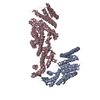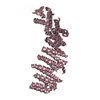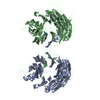+Search query
-Structure paper
| Title | Molecular architecture of the 40S⋅eIF1⋅eIF3 translation initiation complex. |
|---|---|
| Journal, issue, pages | Cell, Vol. 158, Issue 5, Page 1123-1135, Year 2014 |
| Publish date | Aug 28, 2014 |
 Authors Authors | Jan P Erzberger / Florian Stengel / Riccardo Pellarin / Suyang Zhang / Tanja Schaefer / Christopher H S Aylett / Peter Cimermančič / Daniel Boehringer / Andrej Sali / Ruedi Aebersold / Nenad Ban /   |
| PubMed Abstract | Eukaryotic translation initiation requires the recruitment of the large, multiprotein eIF3 complex to the 40S ribosomal subunit. We present X-ray structures of all major components of the minimal, ...Eukaryotic translation initiation requires the recruitment of the large, multiprotein eIF3 complex to the 40S ribosomal subunit. We present X-ray structures of all major components of the minimal, six-subunit Saccharomyces cerevisiae eIF3 core. These structures, together with electron microscopy reconstructions, cross-linking coupled to mass spectrometry, and integrative structure modeling, allowed us to position and orient all eIF3 components on the 40S⋅eIF1 complex, revealing an extended, modular arrangement of eIF3 subunits. Yeast eIF3 engages 40S in a clamp-like manner, fully encircling 40S to position key initiation factors on opposite ends of the mRNA channel, providing a platform for the recruitment, assembly, and regulation of the translation initiation machinery. The structures of eIF3 components reported here also have implications for understanding the architecture of the mammalian 43S preinitiation complex and the complex of eIF3, 40S, and the hepatitis C internal ribosomal entry site RNA. |
 External links External links |  Cell / Cell /  PubMed:25171412 / PubMed:25171412 /  PubMed Central PubMed Central |
| Methods | EM (single particle) / X-ray diffraction |
| Resolution | 2 - 28.1 Å |
| Structure data |  EMDB-2670:  EMDB-2671:  PDB-3j8b:  PDB-3j8c:  PDB-4u1c:  PDB-4u1d:  PDB-4u1e:  PDB-4u1f: |
| Chemicals |  ChemComp-HOH: |
| Source |
|
 Keywords Keywords |  TRANSLATION / TRANSLATION /  translation initiation / translation initiation /  eIF3 complex / PCI-domains / PCI domain / eIF3 complex / PCI-domains / PCI domain /  beta-propeller beta-propeller |
 Movie
Movie Controller
Controller Structure viewers
Structure viewers About Yorodumi Papers
About Yorodumi Papers






